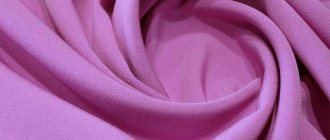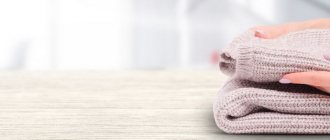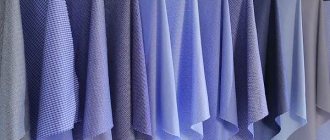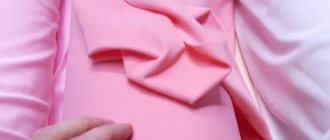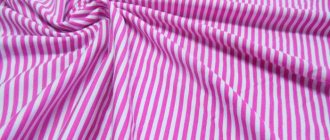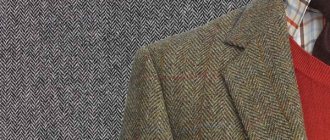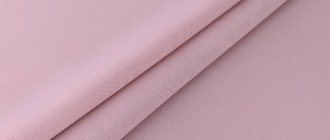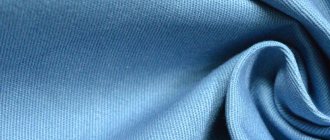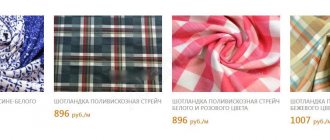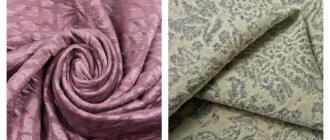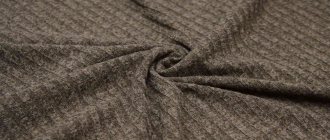Alpaca is a fabric for patchwork and interior decoration. Translated from the Indian language it means “dog”. To produce the fabric, they use the wool and skin of animals that live in the highlands of the Andes. Thanks to a special processing technology, the yarn does not fall into lumps and, accordingly, does not roll down. Alpaca is considered the warmest wool of the animal. Alpaca products are very soft and warm. The fabric drapes beautifully, and thanks to the high density of the fabric, you can sew any product.
The expensive plain or twill weave wool fabric was named after a domestic animal that belongs to the camelid family. Alpacas are bred in South America - in the Peruvian Andes. These beautiful and intelligent creatures were tamed by local residents several thousand years ago.
- In the distant past, their unique and high-quality wool even played the role of currency .
- However, later the Spaniards arrived in their habitat and preferred to raise sheep.
The alpaca returned to its former glory as recently as 1984, when these animals began to be transported from Chile to America. Today, Peru is considered the most famous and largest supplier of wool raw materials. This area has the most suitable conditions for alpaca breeding. The condition and smooth structure of the wool is influenced by the ambient temperature, nutrition with certain mountain herbs, processing technology and even air density.
- The number of tons of alpaca wool per year reaches about 4000. It is important that the animals are sheared only once every two years, so such a large amount of raw material sounds impressive.
Secrets of alpaca production
Alpacas are bred for the purpose of trimming their hair. Despite the fact that it is often impossible to shear these animals, you can get a maximum of three kilograms of wool from one adult alpaca per shearing. The blended fibers are hand-sorted to ensure the finished fiber is of incomparable quality.
After sorting, the threads go through a cleaning stage: craftsmen remove grains of sand, dirt and grass. Next, the spinning process itself begins. Then the finished fabric needs to be washed to remove previously unnoticed debris or greasy stains. The next stage is considered optional: the fabric can be dyed with high-quality dyes or left in its natural form.
- Dyed fabrics may fade when washed , but it all depends on the type and quality of dyes.
Composition, properties, characteristics
Warm, expensive and pleasant to the touch, the fabric combines the softness of llama wool and the healing properties of camel hair. Alpaca wool fibers are suitable for a wide range of weavings as they do not retain their shape. Alpaca is not usually dyed as the wool is available in 22 luxurious natural dyes from white, pearl to brown, coffee and deep black.
These woolen fabrics are stain-resistant, do not pill, do not lose shape, do not stretch or wrinkle. In addition, they can be used for sewing products for allergy sufferers: the fabrics do not cause dangerous allergic reactions. It is comfortable to wear clothes made from alpaca wool in both hot and cold weather. The fabric adapts perfectly to any weather conditions.
- However, for many, the price of this wool may seem too high, which makes this fabric inaccessible to ordinary people.
How does alpaca wool differ from llama wool and from sheep wool?
The main differences between alpaca wool and sheep wool :
- It is seven times more warm than sheep's wool and three times more durable.
- It has extraordinary lightness, but it is more difficult to process than sheep.
- Alpaca wool does not absorb moisture as much and also dries faster.
- At the same time, yarn made from sheep wool fibers is more durable.
Difference between alpaca and llama :
- The first one is much thicker and also longer. Alpacas have hair that grows from their head to their hooves.
- Llama wool is coarser, while alpaca wool is soft and delicate.
- One adult alpaca produces much more wool than a llama.
How is alpaca wool different from llama wool?
Alpaca wool - what is it and how does it differ from llama wool? There is not much difference between alpaca and llama, which allows you to cross them and get the same meat and wool.
Llama wool
Suri alpaca wool is what is best suited for making yarn, as its hairs are thick and silky. Lama does not have thick hair, but makes up for the same volume of fibers with its size.
Note! The alpaca looks like a llama, so the wool of both animals, especially the white color, is most valued, as it looks cleaner and allows for further coloring.
Artiodactyls can bring raw materials of various shades: silver, gray, white, beige, sand and brown. Hair can be wavy, which is valued for its volume and beauty, or straight, suitable for standard clothes.
You might be interested in Description and composition of cashmere: naturalness of the material, description of the fabric
Types of alpaca fabric
There are two generally accepted ways to vary alpaca wool, thanks to which you can easily choose the fabric you need for your purposes. The first of them is based on the type of alpaca, and the second indicator is based on the thickness of the fiber.
Depending on the breed of animal
The difference between the fabrics is obvious depending on the alpaca breed. Suri and Huakaya are considered the most popular and in demand. The first type of alpaca is quite rare, so the cost will be much higher. This wool is considered the best in the whole world.
By fiber thickness
Alpaca is distinguished depending on the size of the fiber:
- The Royal Alpaca is considered the finest. Its fibers are 19 microns thick.
- Baby Alpaca. Fiber diameter is approximately 22.5 microns. It is considered one of the highest quality.
- Very soft. This fabric is made from fibers 25.5 microns thick.
- Adult alpaca. Fiber diameter – 32 microns.
Premium wool - what products are made from alpaca
Particular attention is paid to sewing alpaca coats. Lightweight, wear-resistant elite fabric is suitable for both warm winter and cooler demi-season models. Not only does it retain heat well, but it is also not afraid of bad weather conditions. It will delight you with excellent condition both on the front and back for many years!
- The silky threads of alpaca wool are also loved to create cozy sweaters or jumpers.
Determining the quality level of the material
The quality of wool is difficult to determine by eye to a person far from the world of the textile industry. However, the authenticity and high level of production of the canvas can still be indicated due to the following factors:
Buy fabric or yarn only from trusted suppliers. TISSURA has been collaborating with time-tested brands for many years. Such companies do not hide information and are ready to share it upon request, so if desired, you can track the full fabric production cycle from processing raw materials to creating the finished product.
- High price. Fabric made from 100% alpaca or blends with other elite wool fibers cannot be cheap if first-class raw materials, modern technologies and many years of experience of professionals in their field were used to create them.
You can distinguish it from a fake using a simple experiment. Take the alpaca thread and set it on fire; when it burns, it will smell like an animal, not something burning or resinous.
A product made from natural alpaca will not be too hot or uncomfortable. This fabric does not create a greenhouse effect, unlike fakes made from other materials.
Wool fabric production
Alpaca - what kind of wool is it and how is it produced? To produce yarn from alpaca fabric, you need to first collect the wool by hand. Its quality and volume depend on animal care, nutrition and vitamins, as well as gender. In a year, 6 kg of wool can be collected from a female alpaca (collection is carried out twice a year), and up to 14 kg from a male.
Alpaca yarn
After shearing, higher quality wool is selected and sent for further processing:
- The first stage is manual disassembly of the animal's hair. The furs are distributed according to color, shape, length and thickness.
- At the second stage, the resulting varieties of wool are cleaned: dirt, pieces of grass and debris are removed.
- The third stage is obtaining yarn from the collected material. Before you start spinning, you need to comb the six thoroughly.
- At the final stage, the final cleaning of the finished yarn or product is carried out.
You might be interested in this Features of tweed fabric, what it is made of and where it is used
Note! Wool fibers or yarn can be stored for a long time, this does not affect the quality and preservation of useful qualities.
Alpaca wool
To reduce the cost of the finished alpaca product, it is diluted with synthetic materials or other natural ones (merino, etc.). Thus, the benefits are preserved, and the price is significantly reduced.
Note! To achieve an airy texture, many fashion houses combine silk and alpaca wool, resulting in a beautiful and soft product.
Alpaca sweater
Pros and cons of fabric
The obvious advantages of wool fabric are:
- Lightness and subtlety.
- High breathability, which is characteristic of all natural fabrics.
- Hypoallergenic. A suitable option for allergy sufferers.
- Excellent thermoregulation. Suitable for both cold and warm seasons. Alpaca products are never too hot or too cold. The body in such clothes is always comfortable and comfortable.
- It is considered the warmest wool fabric. At the same time, as mentioned above, you will not sweat in clothes made from this wool, because alpaca does not create a greenhouse effect.
- Does not accumulate static electricity.
Not without its drawbacks:
- High price. This fact is not at all surprising, since transporting raw materials to other countries from South America is an expensive and time-consuming process. In addition, the processing of these raw materials is carried out by real professionals in their field.
- The fabric requires careful handling. Be sure to study the rules for caring for alpaca wool before performing any manipulations.
Features of alpaca socks
Even the most wear-resistant material will quickly become unusable if you do not take care of it. In order for an alpaca product to serve faithfully for several years, it is important to learn how to care for it. It is not difficult. Experts recommend following the following rules:
- Do not use chemicals to protect the product from moths. This insect is indifferent to alpaca wool, but incorrectly selected repellents can ruin an expensive coat. If protection from moths and other “inhabitants” of the closet is necessary, it is better to opt for natural remedies: lavender, wormwood.
- You shouldn't do your own laundry . It is better to entrust this important task to specialists in professional dry cleaning. There it will be cleaned safely and carefully.
- If you can’t visit a dry cleaner, you can wash your coat yourself. But this must be done in cold water (temperature no more than 30 degrees). In this case, the product cannot be wrung out - you need to lay it out on a flat surface, wait until the water drains, and then carefully hang it on the dryer.
- The coat can be ironed, but from the inside out and through a damp cloth. This is recommended only in exceptional cases. Before ironing, it is better to try to straighten out unwanted folds and wrinkles by simply shaking the coat several times and hanging it on hangers.
Important! A product made from this beautiful wool should not be carelessly hung on a hanger by a loop. A beautiful thing requires proper care. The best place in the closet is a prerequisite for long-term wear.
Cost of fabric per meter
The TISSURA Fabric House presents original alpaca wool, delivered to us straight from Peru. Baby alpaca can be bought in our store from 7,300 rubles per meter. Italian Loro Piana coat fabric made from a mixture of alpaca and Australian merino wool is available at a price of 9,100 rubles per meter. The design of the latter is presented in several pastel shades: the Windsor check is available in grey, burgundy and beige. Read more detailed description on our website. The most expensive alpaca fabric costs 89,900 rubles per meter. This fabric from the Swiss brand Jacob Schlaepfer features elegant floral embroidery along the edges, imitating lace.
You can purchase fabrics online in an online store or in our Fabric House, where our experienced employees will advise you. Come visit us, because this way you can not only look, but also touch the canvases, evaluate in person the softness of their surface, check how dense they are, as well as how well the color, pattern or design meets your expectations. In TISSOURA you will find not only alpaca, but also other luxury wool fabrics from leading European brands: angora, vicuna, llama, cashmere and camel hair. For the lining, our staff will help you choose elegant silk options, both plain and printed, for example, striped.
Application
For many years, the unique features of this fabric have been appreciated by many people around the world. In the distant past, alpaca products were available only to a certain class, but today everyone can experience luxury, even though it is not cheap. Alpaca wool yarn is often used not only for making finished fabric, but also for needlework. Popular products that can be sewn from alpaca fabric:
- Outerwear: coats, jackets.
- Accessories: caps, scarves and hats.
- Casual clothing: socks, dresses, sweaters, tracksuits. Particularly convenient are double-sided products that can be turned inside out and worn that way.
- Interior items, a set of home textiles: rugs, bedspreads and carpets. For this category of items, manufacturers often resort to wool raw materials obtained from old alpacas.
The high cost of this wonderful material is justified by the unsurpassed characteristics of natural raw materials. Excellent thermoregulation, durability and excellent aesthetic qualities make clothing made from alpaca wool truly versatile and suitable for wearing all year round.
Alpaca animal
Alpaca - what is it and where does it live? Habitat of the alpaca, a domestic artiodactyl animal, South America. For most of the representatives of this species, the habitat is Peru. Alpaca is kind by nature, very inquisitive and smart, and its wool is used to make the most expensive in its category, but useful fabric.
Alpaca product
Origin story
Alpaca is a representative of camelids. This animal was first domesticated by the Incas more than 6,000 years ago. Historically, alpacas like to stay in herds, so it is impossible to keep the animal alone. To tame an artiodactyl, you need to have patience and perseverance. If an animal makes friends with a person, then it can easily withstand any climate change.
What does an alpaca eat? The most important ingredients are salt and water, as well as oatmeal, rye bread and grass in any form.
How much does an alpaca weigh? Adults weigh about 70 kg, and the total volume of wool that can be collected from an animal per year is 10 kg.
Alpaca Huacaya domestic
Recommendations for care and washing, protection against moths
Rules to follow if you want to extend the life of your favorite woolen product:
Alpaca requires care not only in care, but also in the method of storage. Wool made from such fibers does not like mothballs: if you want to get rid of moths, turn to alternative methods of protection of natural plant origin - lavender or cedar. Do not use synthetic repellents.
- Wash. Before any manipulations, be sure to read the manufacturer's recommendations. Depending on the type of item and its density, you should wash the item in a washing machine or only by hand. Very thin things that become completely thin at the slightest stretch should never be trusted in a machine. Alpaca is washed in cold water (about 30 degrees) with detergents that are specifically designed for this material. Avoid using harsh substances like bleach. You can use dry cleaning services. We recommend washing the item every seven to eight wears to prevent rapid wear.
- Drying. You should not squeeze them, it is better to let the water drain on its own by hanging the product horizontally. Dry away from heating devices and scorching sun. Remember to return the item to its original shape when drying so that the fabric does not become deformed in the process. You can return the pile to a presentable appearance using a brush or a not very hard sponge.
- Ironing. Carefully, on a delicate setting, iron through a damp cloth.
Alpaca wool care
Like any woolen fabric, alpaca does not tolerate high temperatures and frequent washing. It is stored in conditions of moderate humidity, preferably rolled up. Knitted items cannot be hung on hangers - they will become deformed.
Things to consider when caring for an alpaca:
- it is not machine washable;
- the products are not looked at or wrung out;
- the iron is used in case of emergency;
- You can protect your fur from moths using natural means: lavender, tobacco.
If an item has been in the closet for more than a year, there is no need to wash it before going outside. It is enough to refresh it on the balcony. Wash the product by hand in cool water. Rinse at the same temperature. The care and processing of products should be entrusted to professionals if difficult to remove stains or marks appear on the surface.
If the fleecy fabric becomes wrinkled, it can be combed out with a soft brush. Instead of washing powder, you can use shampoo when washing - this option is recommended for light soiling.
Dear readers of the Tkan.Club website, if you still have questions on this topic, we will be happy to answer them. Leave your reviews, comments, share stories if you have dealt with this fabric! Your life experience may be useful to other readers.
